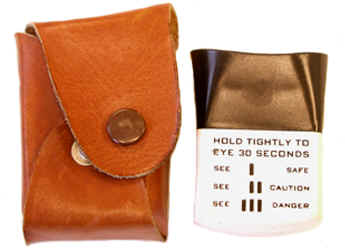GARD Personnel Monitor (ca. 1957-1960)

The GARD monitor shown to the right was produced by the Sargent-Rayment Co. of Oakland, California.
It was quite small (ca. 1.5” x 1.75” x 0.75”), light (ca. 5 grams) and it came in a leather case.
The sensing elements consisted of two CsI (cesium iodide) crystals, which were viewed through the lens on the top of the unit. In addition to the two sensing elements, there is a standard radioluminescent light source used for comparison.
The text on one side reads “GARD, Gamma Atomic Radiation Detector,” while the other side carries the following instructions:
Hold tightly to eye 30 seconds.
See I Safe
See II Caution
See III Danger
The bottom of the unit is stamped with the following "Pat. No. 2,721,724" but this patent is for a "wagon lifting bracket," rather than a radiation sensing device. The actual patent number, issued in 1955, is 2,721,274.
The standard light source (I), which should always be visible, contains approximately 1 uCi of Ra-226 mixed with some type of fluorescent material (probably zinc sulfide). According to the patent, which might or might not be an accurate description of this device, the thicker and more sensitive sensing element (II) would be bright enough to be "discernible in a gamma radiation field of a few Roentgens per hour; and at 20 to 30 Roentgens per hour its light output matches that of the standard." The second sensing element (III) is of such thickness that its light output "equals that of the standard at about 100 Roentgens per hour." In the latter case, "the area should be evacuated at once."
Although it was described in Nucleonics as a personnel monitor, it seems to have had more of a civil defense function.
The following quote is from a UP press release from August or September of 1957:
“the new Gard automatic radiation detector produced by Sargent Rayment Co. Gard to sell for $7.50, is detector for determining presence of harmful radioactive fallout. Made principally for home survey use under emergency conditions of nuclear warfare.”
Donated by Ron Kathren. My sincere thanks also go to David Hickman for tracking down the patent and bringing my attention to the presence of the Ra-226.
References
- Nucleonics November 1957, p. 193.
- S. Patent No. 2,721,274. Radioactivity Detector. David W. Garbellano and Donald R. Cone. Application date: July 7, 1952. Patent issued October 18, 1955.
